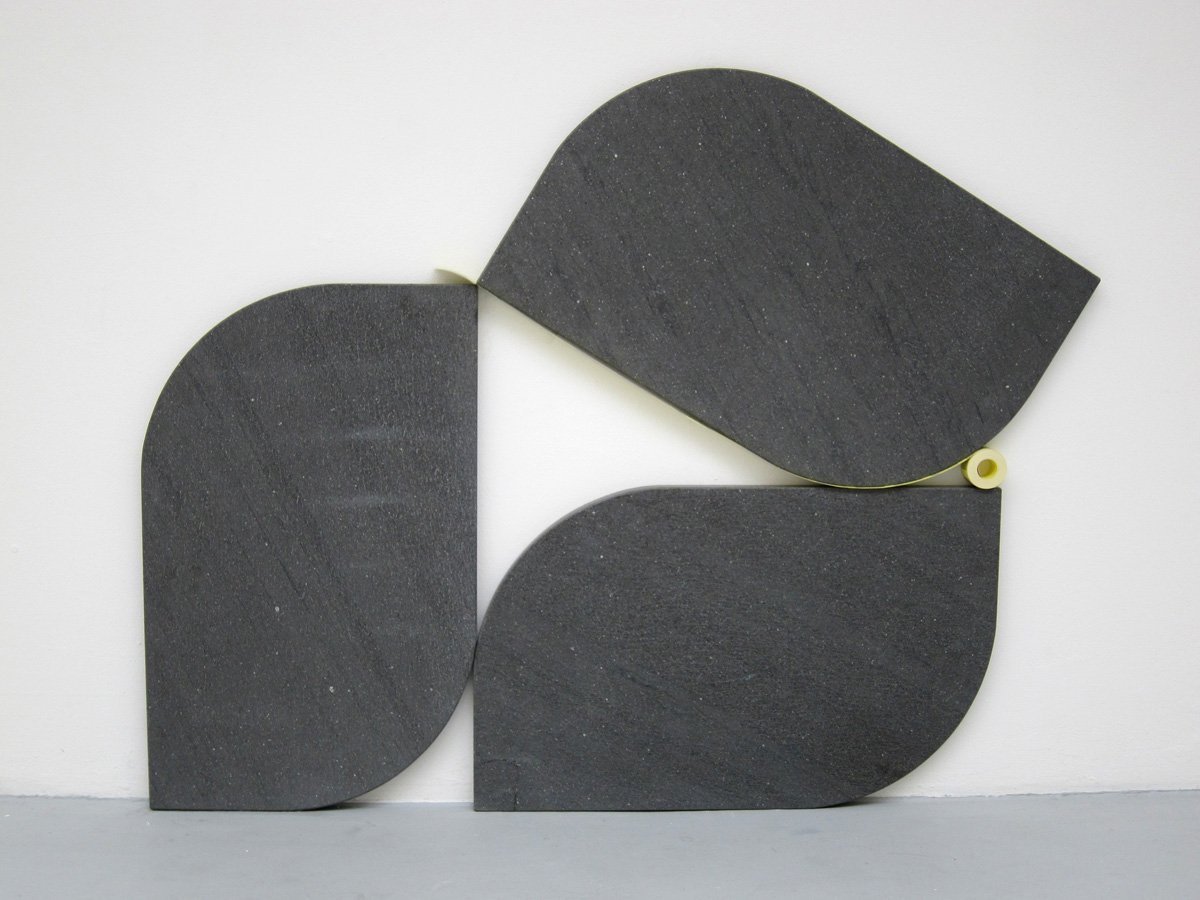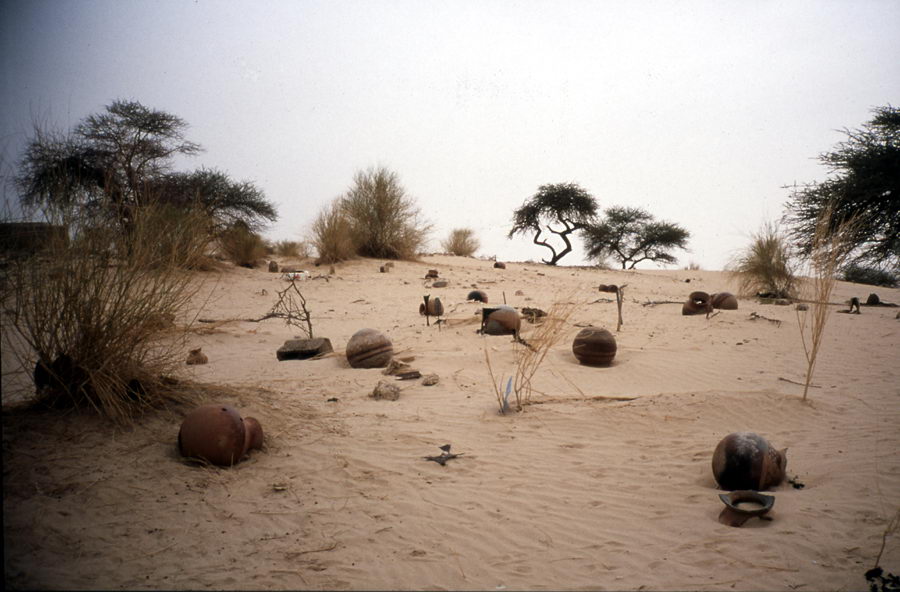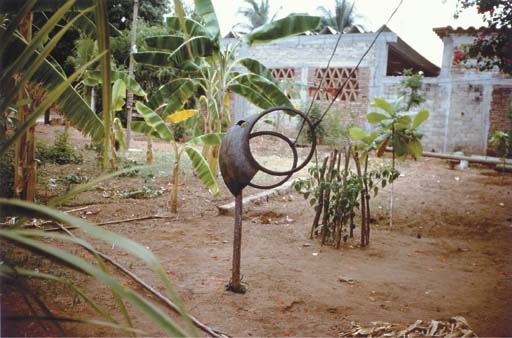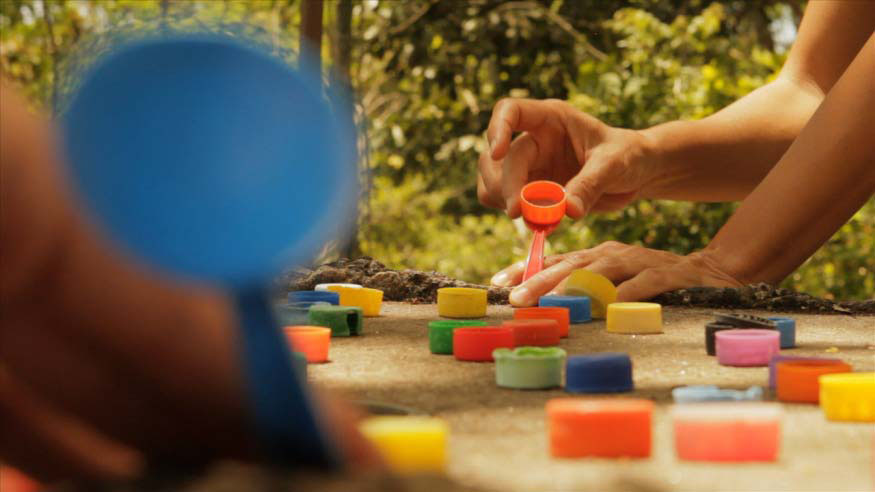
© » KADIST
Minerva Cuevas
Drawing & Print (Drawing & Print)
During her research on primitive currencies and cultural cannibalism, Cuevas came across the Donald Duck comic book issue “The Stone Money Mystery,” where Donald goes on a quest to find missing museum objects. Cuevas’s America (2006) is a wall painting of a comic Donald Duck wallowing in a heap of gold coins, alluding to Mexico’s postrevolutionary mural tradition. The mural’s background is one of the earliest illustrations of flora and fauna in the American continent, juxtaposed with a reference to America as having bountiful natural resources available to be exploited, and the historical use of comics as ideological tools.

© » KADIST
Mario Garcia Torres
Mario Garcia Torres films a game of Charades among professional actors guessing the former North Korean dictator’s favorite Hollywood films. Indeed rather surprisingly Kim seems to have had a huge collection of Western videos and he published a book called “On the art of the Cinema” in 1973. As the final acknowledgments indicate, Garcia Torres’s work was produced following in depth research, consulting information given by director Shin Sang-ok who has been kidnapped by Kim in 1978, as well as Jerrold Post (The George Washington University) and Timothy Savage (Nautilus Institute for Security and Sustainable Development).

© » KADIST
Mario Garcia Torres
Mario Garcia Torres imagines cinematic devices to replay stories occasionally forgotten by Conceptual art. For him, this is a way of rethinking the tradition in a more personal way, to have a grip on events of recent history and examine them with a curiosity, both critical and sensual. The artist emphasizes the fact that new ideas and meanings may arise from these archaeological narratives.

© » KADIST
Tina Modotti
The Italian photographer Tina Modotti is known for her documentation of the mural movement in Mexico. She had a keen eye for architectural composition, and captured eloquent details using a delicate platinum print process. In 1929 she was deported from Mexico because of her involvement in the Communist party and went to Europe.

© » KADIST
Pedro Reyes
Pedro Reyes’s Los Mutantes ( Mutants , 2012) is composed of 170 plates that combine characters from ancient and modern mythologies. As in a periodic table, animals and objects are combined with humans (male or female), providing a rational framework for the irrational products of human imagination. A Cartesian matrix such as this must follow certain rules.

© » KADIST
Mario Garcia Torres
Mario Garcia Torres discovered the work of artist Oscar Neuestern in an article published in ARTnews in 1969. This article, which is the only trace of his work, is indicative of a lack of interest by Neuestern to leave his name in history; to “defend an artistic activity that has little or no interest to last.” Oscar Neuestern could only remember the previous 24 hours, of which his life and his work are in constant erasure and reconstruction. His practice was “to let things be done with time and the unconscious,” while “not fearing the void.” He looked for the absolute through transparency and symmetry.

© » KADIST
Francis Alÿs
Drawing & Print (Drawing & Print)
This series of small drawings is executed with varying materials—pen, ink, colored pencil, charcoal, and masking tape—on architect’s tracing paper. Alÿs often executes such sketches in preparation for his performances, videos, and larger two-dimensional bodies of work. As the first visual representations of his ideas, they capture his thinking processes at the raw conceptual stage and allow us to gain a deeper understanding of his larger works.

© » KADIST
Julieta Aranda
The video Swimming in rivers of Glue is composed of various images of nature, exploring the themes of exploration of space and its colonization. The images show the diversity of forms of life on earth. These forms are associated with texts that relay a form of propaganda.

© » KADIST
Mario Garcia Torres
In Up All Night, Waiting for the Chelsea Hotel Magic to Spark My Creativity Mario García Torres constructs and documents a hypothetical scene, situating himself within a lineage of artists and creatives that used to congregate at the historic hotel. The long-exposure capture depicts García Torres at multiple stages of brainstorming, devising, and introspection, his ethereal figure connected with artistic giants of the past. Yet, there is also an insipid tone beyond mere insomnia or frustration at the lack of being able to garner inspiration.

© » KADIST
Pedro Reyes
In Reyes’s words, “We should be able to extract the technological nutrients before we excrete our waste. There is a missing organ in our social metabolism which would work as a stomach or intestines. The Recyclone is a device made of plastic containers that fit into each other.

© » KADIST
Francis Alÿs
The Nightwatch , which is an ironic reference to the celebrated painting by Rembrandt, follows the course of a fox wandering among the celebrated collections of the National Portrait Gallery in London. The path of the fox, from galleries containing 16th, 17th and 18th century portraits of historic figures from British history hung on plush walls, is circuitous and seemingly random. The fox tracks back and forth, sometimes inspecting the gallery furniture, often walking through the middle of the room but sometimes around its perimeter until eventually it climbs on top of a showcase, covered in fabric where he settles down to sleep.

© » KADIST
Tina Modotti
Modotti’s Diego Rivera Mural: Billionaires Club; Ministry of Education, Mexico D. F., Third Gallery is a photograph of a section of a mural by Diego Rivera in the Ministry of Education in Mexico City. Rivera painted over a hundred frescoes throughout the courtyard of the building, an early mural series that helped revive and popularize the art of mural painting. Modotti, a friend of Rivera’s, took hundreds of photographs of the frescoes which depict divisions of labor in Mexican society.

© » KADIST
Diego Rivera
In 1940 Rivera came to San Francisco for what would be his last mural project in the city, Pan-American Unity . Currently housed at City College of San Francisco as a permanent installation, for a time it was in storage and not on public display. During the same period, he created the charcoal sketchentitled Shasta (1940), of large construction machinery that the artist saw near the Mount Shasta dam.

© » KADIST
Gabriel Kuri
Gabriel Kuri has created a series of works in which he juxtaposes perennial and ephemeral materials. Untitled (Ticket Roll) belongs to this group of sculptures and consists of three smooth ornate marble elements and a roll of public transport tickets. The artist poetically associates finesse and fragility as in a number of these works.

© » KADIST
Abraham Cruzvillegas
Wright Imperial Hotel (2004) is a sort of bow and arrow made out of feathers, a São Paulo phone book, and other materials. The title is a reference to a building Frank Lloyd Wright designed for Tokyo, which was completed in 1923. In its heyday, which lasted until after World War II, the hotel was reserved for elite personnel, many of them foreigners.

© » KADIST
Gabriel Orozco
Gabriel Orozco often documents found situations in the natural or urban landscape. He travels armed with his camera and insightfully captures scenes of the everyday that other people might ignore. Perro en Tlalpan (Dog in Tlalpan, 1992) is a photograph of a dog regally perched under an industrial shelter in the borough of Tlalpan in Mexico City.

© » KADIST
Gabriel Orozco
Gabriel Orozco comments: “In the exhibition [Documenta 11, Kassel, 2002], I tried to connect with the photographs I took in Mali in July. I traveled to Mali for three weeks and took some photographs related to my work. They are very different, but there are links as the graveyard of Timbuktu, which I discovered during the trip.

© » KADIST
Gabriel Orozco
Charco portátil congelado (Frozen Portable Puddle, 1994) is a photographic record of an installation of the same name that Gabriel Orozco made at Witte de With Center for Contemporary Art in Rotterdam for the group exhibition WATT (1994). The artist arrived a week prior to the opening with no artwork to install, and created three spontaneous works from locally sourced materials. This one was made of white plastic record sleeves that Orozco arranged on the damp roof of the gallery.

© » KADIST
Dr. Lakra
Drawing & Print (Drawing & Print)
Like many of Dr. Lakra’s works, Cortes y la malinche is a drawing done on a found vintage magazine page. The text at the bottom of the page, “reclinandose inocentemente sobre el regazo de Hernan-Cortés,” translates to, “reclining innocently in the lap of Hernan Cortés,” and refers to the Spanish conquistador who brought down the Aztec empire. Malinche was a native Mexican who served both as Cortés’s translator in both the Mayan and Aztec languages, as well as his lover.

© » KADIST
Judy Chicago
Domes #1 represents a significant moment in Chicago’s career when her art began to change from a New York-influenced Abstract Expressionist style to one that reflected the pop-inflected art being made in Los Angeles. By 1968, the year she began creating Domes , the twenty-nine-year-old artist had moved from Chicago to Los Angeles, graduated from UCLA, and was part of a generation of artists whose work was characterized by of the masculine overtones of Southern California’s flourishing car culture. Inspired by new technologies in the auto manufacturing, these “Finish Fetish” artists appropriated industrial materials such as car paint or lacquer to create artwork with pristine finishes.

© » KADIST
N. Dash
Dash shapes, manipulates, and molds the materials herself, as the works becomes something of a physical archive. Through these delicate and time-consuming processes, the artist’s bodily interaction with the material becomes clear, with marks of its making and traces of the artist’s hand embedded in the surface of her quiet compositions.
Pedro Reyes
- location: Mexico City, Mexico
- year born: 1972
- gender: male
- nationality: Mexican
- home town: Mexico City, Mexico
Mario Garcia Torres
- location: Mexico City, Mexico
- year born: 1975
- gender: male
- nationality: Mexican
- home town: Monclova, Mexico
Gabriel Orozco
- location: New York City, Paris
- location: Mexico
- year born: 1962
- gender: male
- nationality: Mexican
- home town: Jalapa, Mexico
Tina Modotti
- location: Mexico City, Mexico
- year born: 1896
- gender: female
- nationality: Italian
- home town: Udine, Italy
Yang Guangnan
- location: New York City, United States
- year born: 1986
- home town: Inner Mongolia, China
Abraham Cruzvillegas
- location: Mexico
- year born: 1968
- gender: male
- nationality: Mexican
- home town: Mexico City, Mexico
Minerva Cuevas
- location: Mexico City, Mexico
- year born: 1975
- gender: female
- nationality: Mexican
- home town: Mexico City, Mexico
Dr. Lakra
- location: Oaxaca, Mexico
- year born: 1972
- gender: male
- nationality: Mexican
Diego Rivera
- location: Mexico City, Mexico
- year born: 1886
- gender: male
- nationality: Mexican
- home town: Guanajuato, Mexico
N. Dash
- location: New Mexico & New York
- year born: 1980
- gender: female
- nationality: American
- home town: Miami Beach, Florida
Donna Conlon and Jonathan Harker
- location: Panama City, Panama
- year born: 1966
- nationality: American and Ecuadorian
Gabriel Kuri
- location: Mexico City; Brussels, Belgium
- year born: 1970
- gender: male
- nationality: Mexican
- home town: Mexico City, Mexico
Judy Chicago
- location: Belen, New Mexico
- year born: 1939
- gender: female
- nationality: American
- home town: Chicago, Illinois
Julieta Aranda
- location: Mexico City, Mexico
- year born: 1975
- gender: female
- nationality: Mexican
- home town: Mexico City, Mexico
-
1920-1929
Tina Modotti
1927Modotti’s Diego Rivera Mural: Billionaires Club; Ministry of Education, Mexico D...
-
1930-1939
Tina Modotti
1930The Italian photographer Tina Modotti is known for her documentation of the mural movement in Mexico...
-
1940-1949
Diego Rivera
1940In 1940 Rivera came to San Francisco for what would be his last mural project in the city, Pan-American Unity ...
-
1960-1969
Judy Chicago
1969Domes #1 represents a significant moment in Chicago’s career when her art began to change from a New York-influenced Abstract Expressionist style to one that reflected the pop-inflected art being made in Los Angeles...
-
1990-1999
Gabriel Orozco
1992Gabriel Orozco often documents found situations in the natural or urban landscape...
Gabriel Orozco
1994Charco portátil congelado (Frozen Portable Puddle, 1994) is a photographic record of an installation of the same name that Gabriel Orozco made at Witte de With Center for Contemporary Art in Rotterdam for the group exhibition WATT (1994)...
-
2000-2009
Gabriel Orozco
2002Gabriel Orozco comments: “In the exhibition [Documenta 11, Kassel, 2002], I tried to connect with the photographs I took in Mali in July...
Mario Garcia Torres
2004Mario Garcia Torres imagines cinematic devices to replay stories occasionally forgotten by Conceptual art...
Francis Alÿs
2004The Nightwatch , which is an ironic reference to the celebrated painting by Rembrandt, follows the course of a fox wandering among the celebrated collections of the National Portrait Gallery in London...
Abraham Cruzvillegas
2004Wright Imperial Hotel (2004) is a sort of bow and arrow made out of feathers, a São Paulo phone book, and other materials...
Mario Garcia Torres
2005Mario Garcia Torres films a game of Charades among professional actors guessing the former North Korean dictator’s favorite Hollywood films...
Pedro Reyes
2005In Reyes’s words, “We should be able to extract the technological nutrients before we excrete our waste...
Minerva Cuevas
Drawing & Print
2006(Drawing & Print) During her research on primitive currencies and cultural cannibalism, Cuevas came across the Donald Duck comic book issue “The Stone Money Mystery,” where Donald goes on a quest to find missing museum objects...
Francis Alÿs
Drawing & Print
2006(Drawing & Print) This series of small drawings is executed with varying materials—pen, ink, colored pencil, charcoal, and masking tape—on architect’s tracing paper...
-
2010-2019
Mario Garcia Torres
2010In Up All Night, Waiting for the Chelsea Hotel Magic to Spark My Creativity Mario García Torres constructs and documents a hypothetical scene, situating himself within a lineage of artists and creatives that used to congregate at the historic hotel...
Gabriel Kuri
2010Gabriel Kuri has created a series of works in which he juxtaposes perennial and ephemeral materials...
Yang Guangnan
2011Itch explores the relationship between technology and daily human experience with a motorized arm that extends from within the gallery’s wall, moving up and down while holding a projector that shows a desperately scratching pair of hands....
Pedro Reyes
2012Pedro Reyes’s Los Mutantes ( Mutants , 2012) is composed of 170 plates that combine characters from ancient and modern mythologies...
Donna Conlon and Jonathan Harker
2012In Tapitapultas (2012), Donna Conlon and Jonathan Harker comment on mass consumerism and pollution by way of a game they invented...
Regina José Galindo
2013In 2012, former Guatemalan President José Efran Ros Montt was charged with genocide and crimes against humanity; Regina José Galindo’s video Tierra is a chilling reimagining of the atrocities recounted during his trial...
Julieta Aranda
2016The video Swimming in rivers of Glue is composed of various images of nature, exploring the themes of exploration of space and its colonization...












